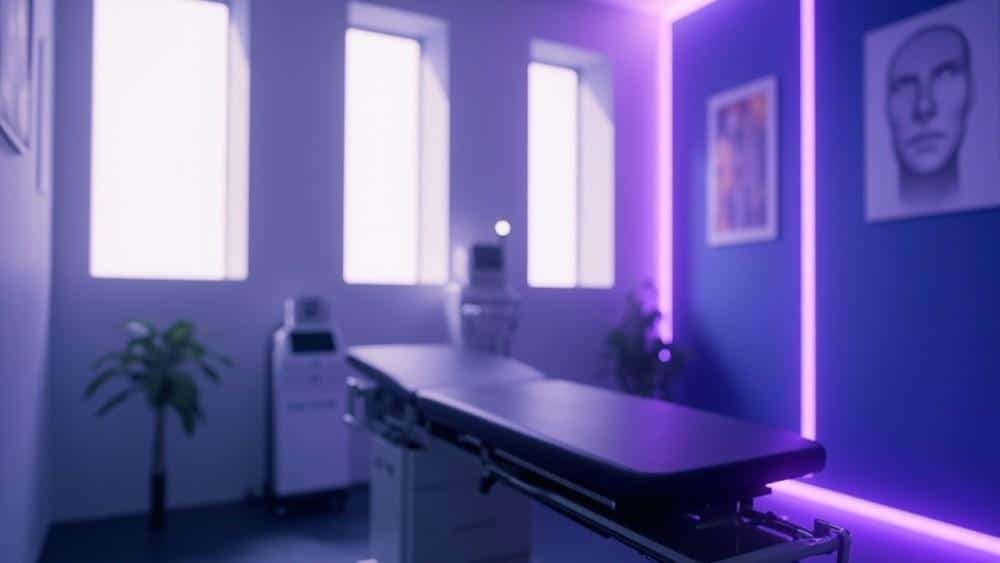Pros And Cons Of Spinal Decompression Therapy: A Physician’s Clinical Perspective
By Dr. Matthias Wiederholz, MD – Quadruple Board-Certified Spine & Regenerative Medicine Specialist
Quick Insights
What is spinal decompression therapy? It’s a non-surgical treatment using gentle traction to relieve pressure on spinal discs, commonly for herniated or degenerated discs. Evidence-based research shows it may improve disc symptoms, but individual results vary. Learn about the Discseel® Procedure as another minimally invasive option for disc repair.
Key Takeaways
- Clinical studies show non-surgical decompression can provide good to excellent outcomes for intervertebral disc lesions.[¹]
- Success depends greatly on choosing the right patients; not ideal for muscular back pain or severe instability.[²]
- Combination with physical therapy outperforms therapy alone for lumbar radiculopathy, a common cause of leg pain.[³]
- Some risks include recurrence of symptoms, cost considerations, and limited evidence for long-term results in advanced degeneration.[⁴]
Why It Matters
If chronic back pain is keeping you from the activities you love, knowing the pros and cons of spinal decompression therapy empowers you to choose a treatment that fits your active lifestyle and avoids unnecessary surgery. Understanding your real options can restore hope and help you regain control.
As a quadruple board-certified interventional pain and regenerative medicine specialist, I bring extensive expertise to the pros and cons of spinal decompression therapy, combining advanced regenerative treatments with compassion for the emotional toll chronic pain can take.
Spinal disc decompression therapy is a non-surgical approach that uses gentle mechanical traction to relieve pressure on the spinal discs—most often for people with herniated discs or degenerative disc disease. For many in Houston, constant back or neck pain can feel isolating and overwhelming, keeping you sidelined from work, sports, or activities you once loved.
Deciding whether spinal disc decompression therapy is the right path means looking closely at both its clinical effectiveness and limitations. Research demonstrates that non-surgical spinal decompression delivers good to excellent results for many patients—but results vary, and the right treatment depends on your unique diagnosis and goals.
If you’re searching for a safe, minimally invasive option in Houston, you deserve honest answers grounded in real clinical experience.
Pros And Cons Summary
Spinal decompression therapy offers a non-surgical path for many patients with disc-related back pain. Here’s a quick, research-backed look at the main advantages and drawbacks:
Pros:
- Non-surgical and minimally invasive
- Can relieve pressure on herniated or degenerated discs
- FDA-cleared and supported by clinical studies
- May improve pain, mobility, and function
- Often combined with physical therapy for better results
Cons:
- Not effective for all types of back pain (e.g., muscular strains)
- Results vary; not a cure for advanced degeneration
- Requires multiple sessions and time commitment
- Some risk of symptom recurrence or incomplete relief
- Out-of-pocket costs and insurance coverage may be limited
As a quadruple board-certified specialist, I believe that selecting the right candidates is the single most important factor for success with spinal decompression therapy. Those with genuine disc pathology—such as herniation or contained tears—see the most reliable benefits, while others may require alternative solutions. This underscores why a thorough diagnostic approach is so essential before starting care. Read more about patient selection for decompression therapy.
Explore symptoms of bulging disc in the neck to determine if decompression may help.

What Is Spinal Decompression Therapy?
Spinal decompression therapy is a non-surgical treatment that uses gentle, controlled traction to relieve pressure on spinal discs. This approach aims to create negative pressure within the disc, encouraging retraction of herniated or bulging material and promoting healing.
In my clinical experience, many patients come to me after years of frustration with pain medications, injections, or even failed surgery—often unaware that safe, gentle, research-backed solutions like non-surgical decompression exist. I see decompression therapy as a way to restore hope and mobility, especially for those looking to avoid invasive procedures.
Types: Surgical vs. Non-Surgical
There are two main types of spinal decompression:
- Surgical decompression involves removing bone or tissue to relieve nerve pressure, typically reserved for severe or progressive cases.
- Non-surgical decompression uses a specialized table to apply traction, stretching the spine in a controlled manner.
Non-surgical spinal decompression is FDA-cleared and widely used for disc-related pain. I recommend this approach for appropriate patients because it avoids the inherent risks, complications, and lengthy recovery associated with open surgery.
Learn about new treatments for ruptured discs.
Common Conditions Treated
Spinal decompression works best for:
- Herniated or bulging discs (when the disc material presses on nerves)
- Degenerative disc disease (age-related disc wear and tear)
- Sciatica (nerve pain radiating down the leg)
- Spinal nerve compression (when nerves are pinched by disc or bone)
It is important to note: spinal decompression is less effective for muscular strains, instability, or pain not arising from disc pathology. Precise diagnosis, through MRI and a detailed exam, helps ensure the right match between therapy and patient need.
For more, see our comprehensive guide to L5-S1 bulging disc.

How Does Spinal Decompression Work?
Spinal decompression works by gently stretching the spine, which changes the force and position of the spinal discs. This process can:
- Reduce pressure on the nucleus pulposus (the soft center of the disc)
- Help retract herniated or bulging disc material
- Improve blood flow and nutrient exchange to the disc
What to Expect During Treatment: You’ll typically lie fully clothed on a motorized table, with a harness securing the pelvis and upper body. The device delivers cycles of traction and relaxation, customized to your individual tolerance and anatomy.
Most decompression protocols involve a series of sessions over several weeks, with each session lasting 20–30 minutes. When paired strategically with targeted physical therapy and anti-inflammatory strategies, as we do in my practice, outcomes are optimized—addressing both the structural and biological drivers of disc pain.
Having performed over 10,000 minimally invasive procedures for spine disorders, I’ve found that collaborative, integrative care yields the highest patient satisfaction and functional gains. Many regain mobility and confidence for the first time in years.
For a detailed summary of decompression’s clinical mechanisms and patient response, see the published imaging outcomes of non-surgical decompression.
Discover L5-S1 pain causes and treatments.
Who Is a Candidate for Spinal Decompression?
Not everyone with back pain will benefit from decompression therapy. The most suitable candidates typically have:
- Documented herniated or bulging discs
- Degenerative disc disease without severe instability or advanced deformity
- Sciatica or nerve compression symptoms
Patients with spinal fractures, tumors, severe osteoporosis, or advanced instability are not good candidates. Determining candidacy involves a thorough review of MRI imaging, medical history, and a detailed physical exam—standards I uphold in every evaluation to safeguard safety and optimize results.
Clinical research shows decompression offers superior results for individuals with true disc problems and is much less effective for muscular pain, inflammation, or instability (see patient selection criteria).
For more insight, explore emergency symptoms of a herniated disc.
Professional Observation: As a master instructor in regenerative spine procedures, I’ve seen firsthand that precise diagnosis and honest expectation-setting are the foundation of success. I always discuss potential benefits and limitations upfront, helping patients make fully informed choices.
Seek medical attention immediately if you experience sudden loss of bladder or bowel control, severe leg weakness, or numbness in the groin area—these may indicate a spinal emergency.
Best painkiller for herniated disc: See your options.

Benefits of Spinal Decompression Therapy
Spinal decompression therapy offers meaningful benefits in properly selected patients:
- Non-surgical pain relief: No incisions, anesthesia, or hospital stays.
- Improved disc health: Helps retract herniated disc material and supports disc healing.
- Function and mobility: Patients frequently report less pain and improved movement.
- Combination therapy advantage: Adding decompression to physical therapy improves pain relief and function, especially for lumbar radiculopathy.
Based on rigorous research, non-surgical decompression plus physical therapy outperforms therapy alone, both statistically and clinically, in improving pain and functional disability in lumbar disc patients see systematic review.
Effectiveness for Herniated and Ruptured Discs
Recent randomized controlled trials (RCTs) confirm that spinal decompression is a validated tool for pain relief and functional gain in patients with herniated and even ruptured discs. RCT evidence for efficacy.
In my experience, many Houston-area patients return to sports, travel, or work after a course of decompression and targeted rehab—sometimes after years of failed treatments elsewhere. It’s always gratifying to see their renewed confidence and energy.
Patient Safety and FDA Status
Non-surgical decompression is FDA-cleared as a treatment for disc-related back and neck pain. The safety profile is excellent when performed by a trained physician and after proper patient screening. Most people experience only mild, transient soreness—serious adverse events are extremely rare.
A systematic review further supports decompression’s safety when combined with physical therapy for lumbar nerve pain.
Read more about degenerative disc disease treatment options.
Risks and Limitations of Spinal Decompression Therapy
Despite its benefits, spinal decompression therapy isn’t a magic bullet and comes with specific risks and limitations:
- Not effective for all pain types: Muscular, inflammatory, or highly unstable spines respond poorly.
- May not provide lasting relief in advanced degeneration or deformity: Advanced bone spurs or multi-level collapse may limit efficacy.
- Requires multiple sessions: It’s a process, not an instant fix.
- Costs and insurance: Out-of-pocket expenses can be significant; insurance coverage varies widely.
According to systematic reviews, decompression is best viewed as part of a broader treatment strategy—not as a universal solution see efficacy/safety review.
Who Should Avoid Spinal Decompression?
The following patients should generally avoid decompression therapy:
- Severe osteoporosis (weak, brittle bones)
- Spinal instability or recent fractures
- Tumors or active infections in the spine
I always perform careful screening—your safety is my absolute top priority. If you’re not a suitable candidate, I’ll discuss more appropriate alternatives and guide you every step of the way.
Potential Side Effects
Side effects are usually mild—most commonly, soreness or transient stiffness after initial sessions. Rarely, pain may increase temporarily, or new nerve symptoms can occur.
Some reviews caution about recurrence or incomplete symptom relief, especially in advanced degeneration. For instance, a comprehensive review noted that incomplete decompression or symptom recurrence may happen in patients with complex spinal anatomy or extensive degeneration review of long-term outcome cautions.
Systematic reviews and coverage policies highlight that while decompression is generally safe, long-term effectiveness and economic impact are still being assessed—making close monitoring important for anyone considering this therapy review of cost-effectiveness and burden.
Managing lumbar degenerative disc disease: Read more.
As a physician dedicated to patient-centered, transparent care, I always ensure my patients have realistic expectations and a clear understanding of both immediate risks and limitations for long-term benefit.
Spinal Decompression vs. Other Back Pain Treatments
When comparing spinal decompression to other options, it’s vital to weigh the effectiveness, risks, and invasiveness of each approach:
- Physical therapy and medications: Often first-line, aimed at strengthening and symptom control. They’re generally effective for mild to moderate pain but may fall short for disc-related issues.
- Epidural steroid injections: Can temporarily ease severe nerve pain but do not restore disc structure.
- Surgical decompression: Reserved for severe, progressive, or refractory cases where nerves are compressed or spine is unstable. Surgery carries higher risks and more downtime.
In my practice, many patients are relieved to learn that surgery isn’t their only option—even after months or years of symptoms.
Physical Therapy and Medications
Physical therapy builds core strength, improves flexibility, and may help relieve pain in early or mild cases. Medications can manage inflammation or discomfort but typically do not repair disc damage. For discogenic pain that doesn’t resolve, additional strategies may be needed.
Explore herniated disc exercises for relief.

Discseel® vs. Traditional Decompression
Discseel® is a minimally invasive, biologic procedure that repairs the annulus fibrosis—the disc’s outer layer—by sealing tears and stimulating natural collagen regeneration, using a fibrin sealant. Unlike decompression, which relieves pressure, Discseel® targets the root cause by reconstructing the actual disc wall.
Through direct training with Dr. Kevin Pauza, inventor of Discseel®, and my ongoing role as a master instructor, I’m able to deliver this advanced technique to patients who might otherwise face fusion or ongoing cycles of symptom management. In many cases where decompression or even surgery has failed, Discseel® has led to restored mobility, lower pain, and renewed quality of life—without hardware, incisions, or prolonged rehabilitation.
Recent comparative analyses find that while surgical decompression can outperform non-surgical options in some spinal stenosis cases, for patients with discogenic pain or contained tears, advanced regenerative treatments like Discseel® offer a safe, outpatient option with high satisfaction rates comparison to surgical intervention.
Ready to get back to living pain-free in Houston? See if you qualify for the Discseel® Procedure
Is Discseel® a Better Alternative in Houston?
For many patients in Houston hoping to avoid major surgery and get back to active living, Discseel® truly represents a revolutionary next step, particularly for those with herniated discs, annular tears, or failed back surgery.
Key advantages of Discseel®:
- 82% success rate—significantly higher than spinal fusion for disc pain
- No incisions, no hardware, no general anesthesia
- Outpatient, with most returning to activity in days
- Preserves mobility and flexibility; avoids fusing the spine
What Sets My Practice Apart:
As one of only a handful of master instructors, trained directly by Dr. Pauza, I’m proud to deliver Discseel® at my Houston and Lawrenceville practices. Unlike large regional centers where patient care can feel impersonal, I personally oversee every step—from diagnosis and procedure to rehabilitation—to ensure your journey is safe, compassionate, and tailored to your goals.
Discseel® is not a “one-size-fits-all” solution but is particularly well-suited for:
- Recurrent herniations after failed treatments
- Discogenic pain with annular tears
- Patients who wish to avoid or have failed spinal fusion
Clinical Perspective: In my experience, the greatest results come from individualized care—matching the right patient with the right therapy, be it decompression, Discseel®, or a combination. My goal is always to help you reclaim a vibrant, active life using the least invasive, most effective option possible.
As with any advanced therapy, success starts with precision in candidate selection. Every patient receives a comprehensive evaluation, imaging review, and a transparent discussion of all options—ensuring your path to recovery is both evidence-based and customized for your needs.
Learn more about Discseel®’s clinical advantages and suitability.
Frequently Asked Questions
Is spinal decompression safe for everyone? Is spinal decompression safe? Spinal decompression is FDA-cleared and generally safe when guided by a trained physician and after careful screening. Most side effects are mild, but it is not recommended for those with instability, fractures, osteoporosis, tumors, or infection. Always get a thorough evaluation to prevent complications. See published safety guidelines here.
How effective is spinal decompression for herniated or ruptured discs? Evidence from randomized controlled trials and systematic reviews demonstrates that decompression can significantly reduce both pain and disability in patients with herniated discs. However, success depends on accurate diagnosis and proper candidate selection. Review the latest clinical research here.
How do I know if I’m a candidate for spinal decompression in Houston? You may be eligible if you have imaging-confirmed disc herniation, bulging, or nerve compression—without instability, fractures, or tumors. The best way to confirm is a personal consultation with an experienced physician who can review your MRI and medical history. Explore candidacy criteria in detail.
Contact us today to schedule your consultation.
What are the pros and cons of decompression therapy compared to surgery?
Pros: Minimally invasive, faster recovery, avoids anesthesia/hospitalization
Cons: Not as effective for advanced degeneration or severe deformity, requires sessions, may not provide long-term relief in some cases
For certain scenarios, surgery may yield better results. See the comparative analysis for spinal stenosis.
Is Discseel® covered by insurance for Houston-area patients? As of now, Discseel® is considered an advanced, elective regenerative treatment and is not widely covered by insurance plans. However, our practice offers transparent pricing and financing options tailored to Houston patients.
Are there long-term studies showing spinal decompression outcomes? Long-term results beyond 12 months are still being evaluated, with some studies reporting significant improvements up to 5 years post-procedure. Recent research questions whether earlier decompression offers additional benefits at the one-year mark see recent study analysis.
Understanding S1 nerve distribution, anatomy, and treatment.

What Our Patients Say on Google
Patient experiences are at the heart of my approach to spine care. Hearing directly from those I’ve treated helps me continually refine my methods and ensure every patient feels supported and understood.
I recently received feedback that captures what we aim to provide at Performance Pain and Sports Medicine. This reviewer shared their experience after receiving facet injections following an accident:
⭐⭐⭐⭐⭐
“Dr. Wiederholz help me tremendously with my injury after my accident. I got my facet injections with him at the surgery center and I had a great experience. I trust and recommend Dr. Wiederholz anytime.”
– Carla
You can read more Google reviews here to see additional patient perspectives.
As a healthcare provider, I am dedicated to delivering care that prioritizes safety, effectiveness, and compassion—whether through spinal decompression, advanced regenerative options, or personalized treatment plans tailored to individual needs.
Comprehensive guide to L5-S1 bulging disc.
Spinal Decompression Therapy in Houston, TX
Houston, TX is a vibrant city where staying active is a priority for many residents. The demands of our local workforce, combined with a love for sports and outdoor activities, mean that back and neck pain can have a real impact on quality of life.
At Performance Pain and Sports Medicine, I see firsthand how spinal decompression therapy can help Houstonians return to work, family, and recreation without the need for invasive surgery. Our clinic is equipped with advanced technology and offers both non-surgical decompression and innovative procedures like Discseel®—all under the care of a quadruple board-certified physician.
Houston’s diverse population also means we encounter a wide range of spinal conditions, from herniated discs to degenerative disc disease. My team and I are dedicated to providing individualized care that addresses each patient’s unique needs, with a focus on safety and long-term results.
If you’re in Houston and considering your options for back or neck pain, I invite you to schedule a consultation. Let’s work together to find the most effective, least invasive solution for your spine health.
Conclusion
To summarize, the pros and cons of spinal decompression therapy come down to careful patient selection, evidence-based technique, and a commitment to restoring both function and hope. Many Houstonians have found real relief and renewed activity through non-surgical decompression—especially when paired with advanced regenerative options like Discseel®. As a quadruple board-certified spine specialist, I believe that honest answers, precise diagnosis, and individualized care are the foundation for lasting results.
If you’re tired of missing out on life because of chronic back pain, I invite you to take the next step. For a deeper look at safety, effectiveness, and evolving treatments, I recommend reviewing recent clinical updates on spinal decompression outcomes. Ready to see if you qualify for Discseel®? See if you are a candidate for the Discseel® Procedure and let’s help you reclaim your life in Houston.
This article is for educational purposes only and should not be used as a substitute for professional medical advice, diagnosis, or treatment. Always seek the advice of your physician or other qualified healthcare provider with any questions you may have regarding a medical condition or treatment options. Never disregard professional medical advice or delay in seeking it because of something you have read in this article.

















